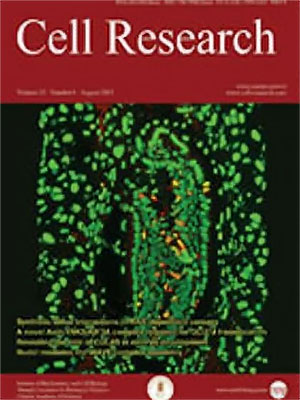
Volume 14, No 2, Apr 2004
ISSN: 1001-0602
EISSN: 1748-7838 2018
impact factor 17.848*
(Clarivate Analytics, 2019)
Volume 14 Issue 2, April 2004: 148-154
ORIGINAL ARTICLES
Binding activity of H-Ras is necessary for in vivo inhibition of ASK1 activity
Jun DU1, 2*, Shao Hui CAI3, 4, Zhe SHI3, Fumihiko NAGASE1
1Department of Medical Technology, Nagoya University School of Health Sciences, Aichi 461-8673, Japan.
2School of Pharmaceutical Science, Sun Yat-Sen University, Guangzhou, 510089, China.
3Department of Immunology, Nagoya University Graduate and Faculty School of Medicine, Aichi, 466-8550, Japan.
4College of Pharmacy, Jinan University, Guangzhou, 510632, China.
Correspondence: Jun DU(togun@met.nagoya-u.ac.jp )
H-Ras is well known as one of the essential components of Ras/Raf/MEK/ERK cascade, which is a critical prosurvival signaling mechanism in most eukaryotic cells. Ras targets Raf/MEK/ERK cascade by integrating and transmitting extracellular signals from growth factor receptors to Raf, leading to the propagation of signals to modulate a serious of cellular survival events. Apoptosis signal-regulating kinase1 (ASK1) serves as a general mediator of cell death because it is responsive to a variety of death signals. In this study, we found that H-Ras interacted with ASK1 to cause the inhibition of both ASK1 activity and ASK1-induced apoptosis in vivo, which was reversed only partially by addition of RafS621A, an antagonist of Raf, whereas MEK inhibitor, PD98059, and PI3K inhibitor, LY294002, did not disturb the inhibitory effect of H-Ras on ASK-1-induced apoptosis. Furthermore, by means of immunoprecipitate and kinase assays, we demonstrated that the interaction between H-Ras and ASK1 as well as the inhibition of ASK1 activity were dependent on the binding activity of H-Ras. These results suggest that a novel mechanism may be involved in H-Ras-mediated cell survival in addition to the well established MEK/ERK and PI3K/Akt kinase-dependent enhancement of cell survival.
FULL TEXT | PDF
Browse 1938


